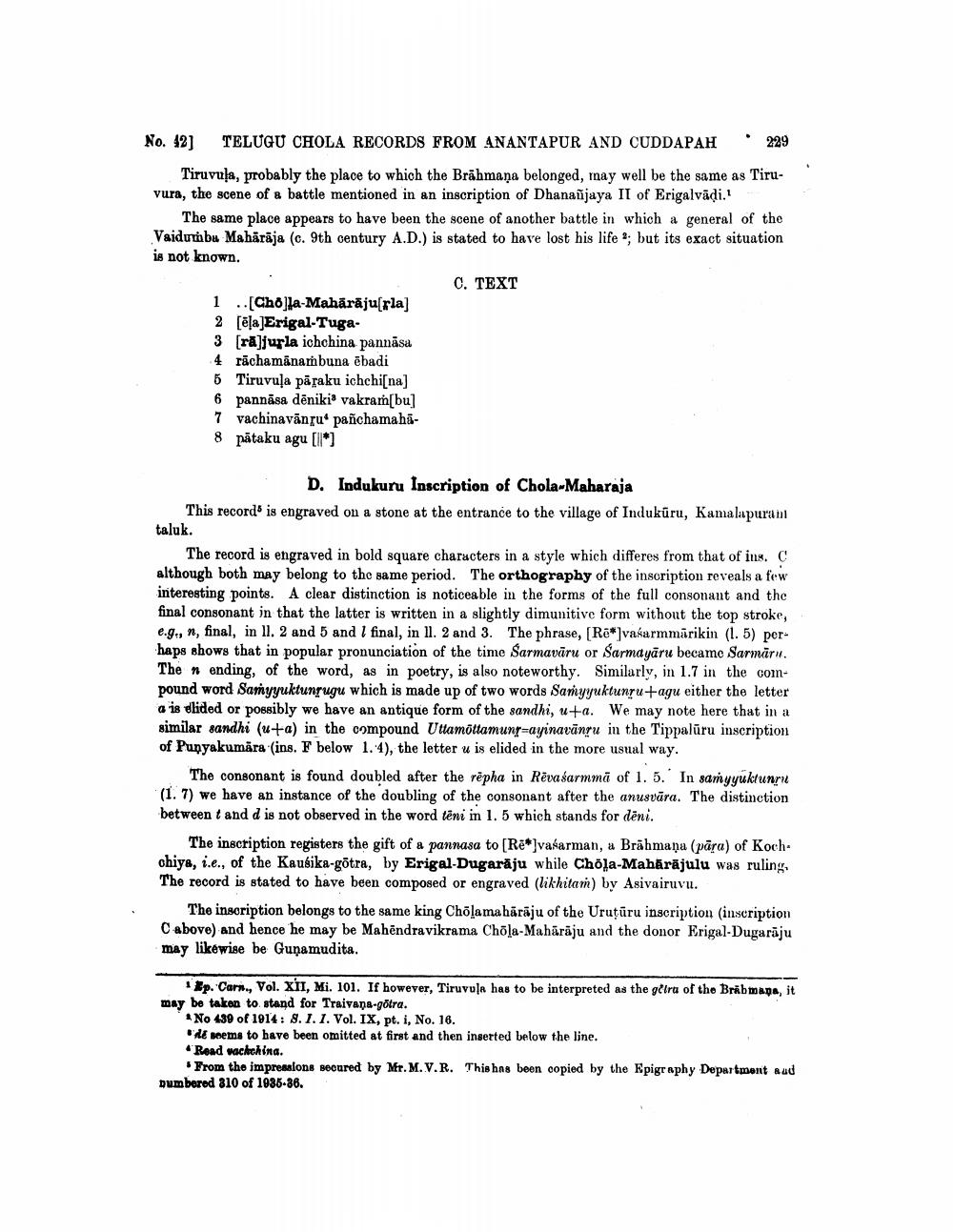________________
No. 42]
TELUGU CHOLA RECORDS FROM ANANTAPUR AND CUDDAPAH
Tiruvula, probably the place to which the Brahmana belonged, may well be the same as Tiruvura, the scene of a battle mentioned in an inscription of Dhananjaya II of Erigalvāḍi.1
The same place appears to have been the scene of another battle in which a general of the Vaidumbu Mahārāja (c. 9th century A.D.) is stated to have lost his life 2; but its exact situation is not known.
1.[Chola-Mahārāju[rla]
2 [ēla]Erigal-Tuga
3 [raljurla ichchina pannāsa
4 rachamanambuna ĕbadi
5 Tiruvuļa pāraku ichchi[na]
6 pannāsa dēniki3 vakram[bu]
7 vachinavānru pañchamaha
8 pataku agu [*]
229
C. TEXT
D. Indukuru Inscription of Chola-Maharaja
This record is engraved on a stone at the entrance to the village of Indukūru, Kamalapuram taluk.
The record is engraved in bold square characters in a style which differes from that of ins. C although both may belong to the same period. The orthography of the inscription reveals a few interesting points. A clear distinction is noticeable in the forms of the full consonant and the final consonant in that the latter is written in a slightly dimunitive form without the top stroke, e.g., n, final, in 11. 2 and 5 and I final, in 11. 2 and 3. The phrase, [Re*]vasarmmarikin (1.5) perhaps shows that in popular pronunciation of the time Sarmavaru or Sarmayāru became Sarmāru. The ending, of the word, as in poetry, is also noteworthy. Similarly, in 1.7 in the compound word Samyyuktunṛugu which is made up of two words Samyyuktunṛu+agu either the letter a is elided or possibly we have an antique form of the sandhi, u+a. We may note here that in a similar sandhi (u+a) in the compound Uttamottamung-ayinavänṛu in the Tippaluru inscription of Punyakumara (ins. F below 1.4), the letter u is elided in the more usual way.
The consonant is found doubled after the repha in Rēvasarmma of 1. 5. In samyyuktunṛu (1.7) we have an instance of the doubling of the consonant after the anusvara. The distinction between t and d is not observed in the word têni in 1. 5 which stands for deni.
The inscription registers the gift of a pannasa to [Re*]vasarman, a Brāhmaṇa (pāra) of Kochchiya, i.e., of the Kausika-gōtra, by Erigal-Dugaraju while Chōla-Mahārājulu was ruling, The record is stated to have been composed or engraved (likhitam) by Asivairuvu.
The inscription belongs to the same king Chōlamahārāju of the Uruțuru inscription (inscription Cabove) and hence he may be Mahendra vikrama Chōla-Mahārāju and the donor Erigal-Dugarāju may likewise be Gunamudita.
1 Ep. Carn., Vol. XII, Mi. 101. If however, Tiruvula has to be interpreted as the getra of the Brahmana, it may be taken to stand for Traivana-götra.
No 439 of 1914: 8. I. I. Vol. IX, pt. i, No. 16.
de seems to have been omitted at first and then inserted below the line.
Read vachchina.
From the impressions secured by Mr. M.V.R. This has been copied by the Epigraphy Department aud numbered 310 of 1935-36.




